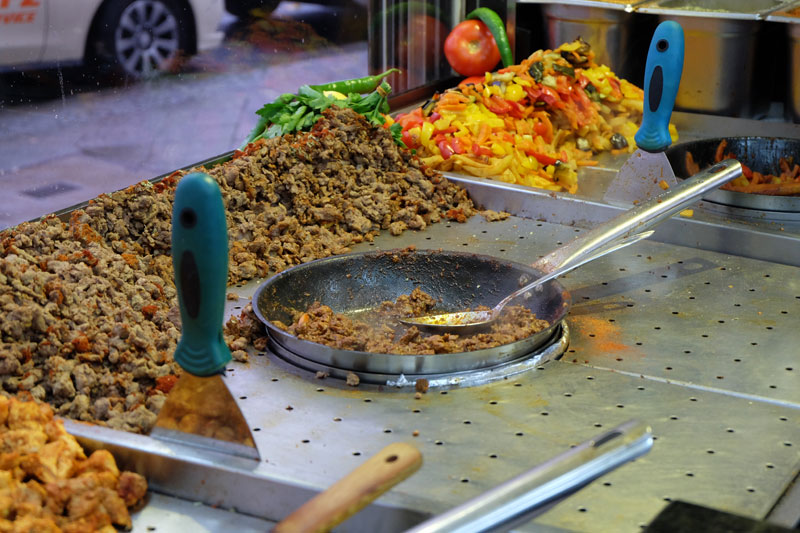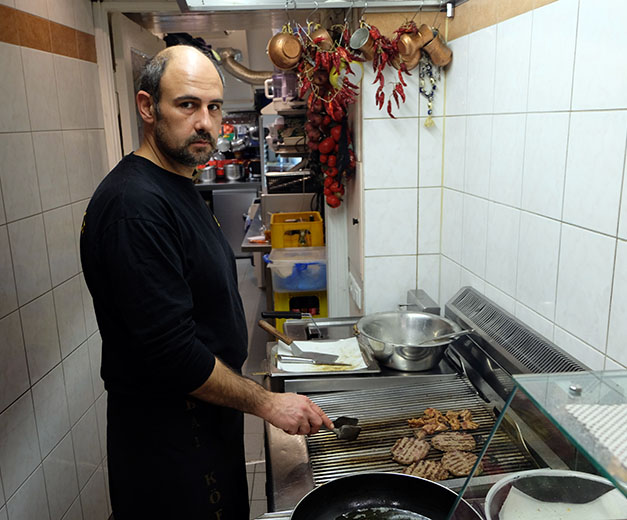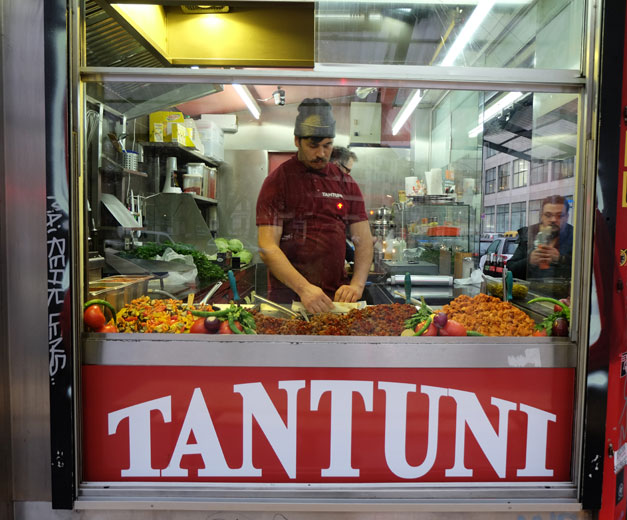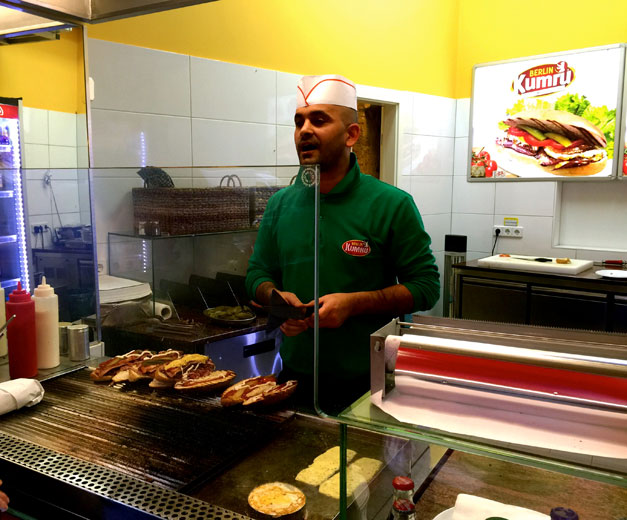We can't find the internet
Attempting to reconnect
Something went wrong!
Hang in there while we get back on track
Search results for "Paul Benjamin Osterlund"
Istanbul
Lipa: Meze On the Edge of Town
Convincing someone to accompany you to Istanbul’s Pendik district is no small feat. The Asian-side suburb is located in the far eastern reaches of the city, a trip of at least an hour and a half from the city center requiring no less than three metros and a cab. We've been met with moans and groans upon mentioning the name, as the district is synonymous to many with the wildfire-like urban sprawl that has engulfed Istanbul over the years. Those up for the journey, however, are rewarded handsomely at Lipa, a meyhane serving Bosnian specialties. The neighborhood of Sapan Bağları is home to a large population of natives from Sandzak, a predominantly Bosnian Muslim region now split across modern-day Serbia and Montenegro.
Read moreIstanbul
A Slice of Georgian in a Pocket of Istanbul
We frequently venture to Istanbul's Aksaray district, where a small cluster of Georgian restaurants lie in close proximity to a bus station bringing people to and from the Caucasus. Giorgi serves up decadent, buttery khacaphuri and other Georgian classics, temporarily transporting one to Tbilisi.
Read moreElsewhere
Toros: Tantuni (the Kreuzberg Remix)
(Editor's Note: In honor of the immigrants and refugees who have made their new home a better place for us all, this week we are running some of our favorite archived stories about those who have left a culinary mark on their adopted land.) In Berlin, there is no shortage of meatless options, and vegetarians can even rejoice in a seitan-based döner kebab that is given the proper spit roast. What did surprise us is that the ubiquity of vegetarian diets in the city has greatly impacted one version of a meat-centric Turkish street food classic.
Read moreIstanbul
Çiğköftecisi Orhan Usta: Heat Merchant
Visitors to Istanbul's iconic Spice Bazaar encounter a place packed wall-to-wall with overzealous shopkeepers selling everything from saffron to sumac assembled in rows of majestic pyramids at slightly inflated prices. But for our money, the only spices worth a damn are found just outside in a humbler setting. Crammed behind a tiny kiosk perched in front of a fast-food restaurant that flanks one of the bazaar's entrances is the endearing Orhan usta. The loveable 65-year-old is a veritable master of çig köfte and a connoisseur of the spicy red pepper flakes cultivated in his hometown of Gaziantep, the southeastern city considered by many to be Turkey's culinary capital.
Read moreIstanbul
A Much-Needed Istanbul Blizzard
A heavy snowstorm left a thick layer of powder in Istanbul, resulting in cancelled classes for several days, and the arrival of countless snowmen. Snowball fights broke out left and right, neighborhood kids used whatever they could to slide down icy hills. Demeanors softened, moods improved. After a tragic beginning in 2017, the city received a much-needed blessing from the sky.
Read moreIstanbul
Asır: Meze Master
On our way to dinner one Friday evening, we hopped in a cab headed for Tarlabaşı, a rather infamous neighborhood in the dead center of Istanbul in which many people still refuse to set foot. The area was a longtime hotbed of Greek and Armenian artisans and tradesmen, once the backbone of Ottoman-era Istanbul’s commercial life, who erected rows of gorgeous European-style apartment buildings beginning in the 19th century. Many stand proudly today, while dozens of others are fenced off and awaiting renovation as part of an invasive gentrification project that seeks to remodel the now decrepit, impoverished Tarlabaşı. By the end of 1970s, Tarlabaşı's Greeks and Armenians had packed up and left the neighborhood and the country, following difficult decades of anti-minority policies and attacks. In their place came a motley crew of other disenfranchised people: Kurds fleeing conflict in the southeast of the country, Roma living on the fringes of society, transgender sex workers, economic migrants and political refugees.
Read moreIstanbul
Best Bites 2016: Istanbul
One of our most exciting discoveries this year was Yılmaz Tandır Evi in Istanbul's Feriköy neighborhood, where many people from the eastern Anatolian province of Erzincan have settled over the years. Yılmaz İngeç, a native of Erzincan's İliç district, serves only the finest ingredients from his hometown, including fresh honey, kavurma and tulum peynir, a salty, crumbly cheese aged in goatskin. A simple serving of fried eggs topped with tulum was a match made in heaven, perhaps our favorite breakfast this year. We were thrilled to stumble upon a secluded slice of the Black Sea province of Trabzon right here on the Asian side of Istanbul earlier this fall.
Read moreIstanbul
Hadramot Yemen: Beyond Falafel
Istanbul's conservative Fatih district has perhaps the highest concentration of Syrian refugees in the city, and the tree-lined Akşemsettin Street boasts a staggering number of Syrian eateries, from spacious sit-down affairs with full menus to hole-in-the-wall, standing-room-only kiosks slinging shawarma, fried chicken, and falafel. Having popped up rapidly amid the waves of Syrians fleeing the devastating civil war that has displaced more than half the country's population, these establishments have made a firm imprint on the culinary scene. While the falafel at many of these places is a mediocre afterthought overshadowed by the more popular poultry-based items, we found one counter offering falafel and falafel only, serving up a generously crafted sandwich the size of a chubby child's forearm for a measly TL 2.50 (US$0.75).
Read moreIstanbul
Yıldırım Usta’s Kebab: Tailgate Party
Kurtuluş Son Durak is a busy intersection and transit hub that’s a hive of activity 24 hours a day. Marking a transition between the tidy, middle-class Kurtuluş neighborhood and the rough-and-tumble quarters of Dolapdere and Hacıahmet, the area is home to a host of eateries and cafes that never seem to close. Right in the center of it all, we stumbled across a diminutive white van rigged with a makeshift grill. Inside the tiny, elaborately decorated vehicle crouched Yıldırım Usta, a 75-year-old veteran of the kebab trade who has been serving up truly delicious dürüm – kebab wrapped up in flatbread – on Kurtuluş Son Durak for 28 years.
Read moreIstanbul
Trabzon Kültür Derneği: Geography Is (Delicious) Destiny
Located just beneath Istanbul’s first Bosphorus Bridge in the Anatolian side district of Üsküdar is a secluded slice of Trabzon, the Black Sea province known for its otherworldly lush green forests, hot-tempered inhabitants and distinctly deep cuisine. The Trabzon Kültür Derneği (Trabzon Cultural Association) is something of a clubhouse for folks who grew up in the province and later moved to Istanbul for school and work. Founded in 1970 and having changed locations a number of times, the association set up shop in Üsküdar’s Beylerbeyi neighborhood at the turn of the millennium and crafted a miniature version of home in the heart of Turkey’s largest, ever-sprawling city.
Read moreIstanbul
Sinem Kebap: Love at First Scent
We got hungry after doing some serious exploration in the Asian-side neighborhood of Mustafa Kemal, a hotbed for left-wing groups and a melange of informally built homes in the shadow of the rapidly developing district of Ataşehir. Passing by a string of uninspiring döner and pide joints, we inevitably opted to do what works best: follow our noses. The ragtag quarter is better known as 1 Mayıs, taking its moniker from a bloody, chaotic scuffle in Taksim Square on May Day, 1977, that left over 30 dead. Home to a working-class Alevi population of Central and Eastern Anatolian migrants who came to Istanbul in the 70s, the neighborhood is tagged on every other wall with the acronyms of leftist groups (legal and illegal alike) alongside posters of martyred revolutionaries
Read moreIstanbul
Behind Bars: Drinking in the Bosom of Abraham at Urfa’s Cafe Antik
Urfa's old city is an invigorating array of tones and sounds. Dominated by an intriguing maze of narrow streets, the buildings all share the same sun-baked sandy hue, suggesting that they rose up from the earth on their own centuries ago. Landscape and cityscape blend into one here, and cars are outnumbered by ornately painted motorbikes equipped with sidecars, vehicles perfectly equipped to navigate roads too narrow for vans and sedans. Older men don poşu scarves of varying color combinations, and Arabic is spoken more frequently than Turkish. Believed by locals to be the birthplace of Abraham, Urfa is known as the “City of Prophets.” The municipality proudly advertises this fact.
Read moreIstanbul
Behind Bars: Drinking in the Bosom of Abraham at Urfa’s Cafe Antik
Urfa's old city is an invigorating array of tones and sounds. Dominated by an intriguing maze of narrow streets, the buildings all share the same sun-baked sandy hue, suggesting that they rose up from the earth on their own centuries ago. Landscape and cityscape blend into one here, and cars are outnumbered by ornately painted motorbikes equipped with sidecars, vehicles perfectly equipped to navigate roads too narrow for vans and sedans. Older men don poşu scarves of varying color combinations, and Arabic is spoken more frequently than Turkish. Believed by locals to be the birthplace of Abraham, Urfa is known as the “City of Prophets.” The municipality proudly advertises this fact.
Read moreIstanbul
Chaos and Köfte: Istanbul Rebounds After Coup Attempt
On the night of July 15, electricity consumption on the European side of Istanbul rose by a staggering 52 percent. People frantically clutched their smartphones, plugged in their chargers, and remained glued to their TV screens. Turks watched with terror as a military coup attempt played out like a twisted B action movie. Tanks ran over people and shot them in the street. An F-16 left a sonic boom in its wake sounding no different than an exploding bomb. Jets fired on the parliament building in Ankara.
Read moreIstanbul
Simitçi Feridun: May the Simit Be Unbroken
The sound of bombs has become an all too frequent occurrence in Istanbul as of late, and residents of the city's Cihangir neighborhood were spooked as ever when an explosion occurred in a building overlooking the main square early on a recent Sunday morning. Blasts sound no less scary when they are the result of gas leaks. When the smoke cleared, 75-year-old Feridun Yükseltürk was found crushed under the fallen rubble, just steps from the spot where he sold simit from a cart daily for the past six years. The tragedy sent shockwaves through Cihangir, where Feridun was a beloved figure renowned for his unwavering generosity.
Read moreIstanbul
Behind Bars: Terminal Nostalgia at Mythos
In Istanbul's iconic Haydarpaşa train terminal, the door of a crowded restaurant and bar opens to beams of sparkling light streaming across the Marmara Sea coast. Trains haven't departed Haydarpaşa for nearly three years while the station undergoes extensive renovations, but its restaurant, Mythos, is still open and popular as ever, a refuge for a faithful crowd of regulars, who come to drink at a train station even though they aren’t going anywhere. Built in the first decade of the 20th century by the Germans and gifted to Sultan Abdülhamid II, the station is a handsome and prominent icon of the city, an imposing presence on the city's Anatolian shoreline.
Read moreIstanbul
Around Kumkapı – and the World – in a Day
In Istanbul, there is a single neighborhood where one can find Uzbek mantı, imported Ethiopian spices and hair products, smuggled Armenian brandy, Syrian schwarma and sizzling kebap grilled up by an usta hailing from southeast Turkey’s Diyarbakır. Kumkapı – a shabby seaside strip of century-old homes, Greek and Armenian churches and residents from a vast array of countries that most Americans couldn't pick out on a map – is far and away the most diverse place in Istanbul. Nowhere else comes close. In perpetual motion, Kumkapı is home to a rotating cast of eclectic restaurants that cannot be found anywhere else in the city. Many of these open and close before we can squeeze in a second visit.
Read moreIstanbul
Feriköylu Ömer Usta: Köfte Club
The triangle of Kurtuluş, Feriköy and Bomonti represents an Istanbul on the verge of fading away. Though still inhabited by significant numbers of Greeks, Jews and Armenians, there are more local churches and synagogues than are used by the remnants of those diminished communities. The numerous schools, houses of worship and cemeteries are relics testifying to the cosmopolitanism that once defined this segment of inner Istanbul. Another nostalgic quality of the area is its small-business culture, still thriving, yet on the verge of a major shift.
Read moreIstanbul
Horhor Dürüm Evi: Family (Kebab) Values
We could devote a weekly column to the culinary treasures of Istanbul’s polyglot Aksaray district and probably never have to worry about running out of things to say. The area is jam-packed with places to eat, and while we've written about many of them, Aksaray just keeps on delivering. Having previously covered the Syrian, Georgian, Azerbaijani and Uighur restaurants that make Aksaray a true patchwork of culinary destinations, our most vulnerable soft spot still lies in the strip of kebab restaurants inspired by the cuisine of southern Turkey’s Hatay and Urfa and located adjacent to the metro station.
Read moreIstanbul
Late-night Sucuk Ekmek in Beşiktaş
After midnight deep in the heart of Beşiktas, these two gentlemen can be found slinging grilled sandwiches of thin, sliced sucuk, peppers and tomatoes. It's one of our favorite street snacks, and one of the perfect follow ups to a cold one or four.
Read moreIstanbul
Easter in Istanbul
In the Istanbul neighborhood of Kurtuluş, home to a large Armenian population, a number of shops are decorated on account of Easter, and the smell of traditional sakızlı Paskalya çöreği--puffy loaves of ever-so-slightly sweet bread baked with mastic gum--is thick in the air.
Read moreIstanbul
Yılmaz Tandır Evi: Little Erzincan
Wave after wave of migration from Anatolia has bestowed upon Istanbul a population of 15 million at bare minimum, with countless pockets of the city representing villages and districts from every last corner of the country. In the neighborhood of Feriköy, those originally hailing from the eastern province of Erzincan have managed to consolidate their presence on an entire street. Lined with a number of restaurants and shops selling fresh goods typical of the province, and a row of village associations established for the purpose of maintaining cultural ties between those living in Istanbul and their relatives back home, Feriköy's Gediz Sokak is all about Erzincan, a land of sheep and mountains famed for its dairy products.
Read moreIstanbul
Damla Dondurma-Boza: Micro Brew
We’re not quite sure what we like about boza, a drink made from slightly fermented millet that is popular in Istanbul during the wintertime. The thick beverage tastes like a combination of applesauce and beer-flavored baby food, though we warmly recall the strength it gave us one blustery December day. On that relentlessly rainy morning as we crossed the Bosphorus aboard the ferry from Kadıköy to Eminönü, just one small bottle of boza gave us a sharp kick in the britches, making us feel the way we imagine Popeye does after wolfing down a can of spinach.
Read moreIstanbul
Korkmaz Büfe: Poetry in Rotation
Istanbul’s Kadıköy district on the city’s Asian side has long been billed as a calmer, more laid-back alternative to some of its swarming, chaotic European counterparts, and it seems everyone’s figured that out by now. Though the rocks that straddle a long stretch of winding, serene shoreline still make for one of the most relaxing hangout places in the city, the pedestrian Mühürdar Caddesi running through the heart of Kadıköy is choked with foot traffic on the weekends, while a staggering number of bars and coffee shops have appeared on the scene within the past two to three years.
Read moreElsewhere
Bal Köfteci: Sweetish Meatballs
It might sounds sacrilegious, but when we’re in Berlin, döner isn’t our go-to street sandwich. Though it is widely believed that the German capital is the birthplace of the beloved sandwich, that fact alone does not provide citywide quality assurance. The rapid ascension of the döner sandwich as the city’s eminent fast-food staple has unfortunately resulted in its mass production, which means one is likely to encounter a nondescript rotating wheel of frozen mystery meat. This isn’t to say that excellent yaprak döner (a carefully crafted cylinder consisting of freshly layered cuts) cannot be found in Berlin. But the way the sandwich is dressed in this city – with a variety of vegetables, sauces, cheese and fresh-squeezed lemon or lime – is indeed conducive to covering up the taste of boring meat.
Read moreElsewhere
Toros: Tantuni (the Kreuzberg Remix)
In Berlin, there is no shortage of meatless options, and vegetarians can even rejoice in a seitan-based döner kebab that is given the proper spit roast. What did surprise us is that the ubiquity of vegetarian diets in the city has greatly impacted one version of a meat-centric Turkish street food classic. Toros Tantuni is a small stand that occupies a rather lonely corner of the central part of the Kreuzberg district, a place once inhabited by a ragtag mix of immigrants, squatters and activists, ignored by most Berliners who could afford to live elsewhere. In recent years, however, the area has been thoroughly spritzed with the essence of gentrification and has a flood of innumerable bars, coffee shops and boutiques.
Read moreElsewhere
Berlin Kumru: Ich Bin Ein İzmirli
The kumru sandwich – a specialty of Turkey's Aegean coastal resort district Çeşme – is one of our top guilty pleasures. It comes as heavy on the guilt as it does on the pleasure, with its sodium-laden, coma-inducing blend of grilled hot dog strips, salami slices and buttons of garlicky sucuk topped with melted kaşar cheese, fresh tomatoes and pickles served on a grill-toasted roll somewhat resembling a turtledove (kumru in Turkish).
Read moreIstanbul
Dürümcü Mehmet’in Yeri: The Sharing Economy
Istanbul’s Aksaray neighborhood harbors an unfortunate reputation derived from its seedy nightclubs and the heavy presence of illegal brothels, which turn profits from sex trafficking. But as the city continues to transform at dizzying speeds, Aksaray’s status as an underbelly has begun to be overshadowed by that of a diverse, exciting culinary destination. Streetside Syrian cafés churning out cheap and reliable falafel and shawarma; a handful of Uighur restaurants serving dishes of spicy peppers and succulent morsels of beef bathing in handmade noodles prepared to order; and Georgian drinking dens, where chacha, a grape-based moonshine, is brought out in plastic water bottles alongside juicy, lovingly made dumplings, are just a few of the international cuisines that can be sampled in Aksaray.
Read moreIstanbul
Meşhur Öz Suruç: The Yellow and the Green
To the uninitiated, the restaurant owners of a small corner of Istanbul’s Yenibosna neighborhood might come off as having an unhealthy obsession with particularly garish versions of the colors yellow and green. As we recently explored the lower end of the Yenibosna neighborhood, one of Istanbul’s large periphery boroughs, we stumbled upon a small cluster of kebap shops spread out amid a run-down yet bustling strip of auto repair shops and congested rows of apartments, with each eatery’s sign decked out in identical yellow and green trim.
Read moreIstanbul
Bus Fare: A Transit Terminal's Food to Go
The Yenibosna bus station sits at the intersection of numerous transit routes, where passengers can embark on journeys to the furthest corners of the city as well as to its beating heart. Close to Istanbul’s main airport, and wedged in beneath several high-rise towers that seem to have ascended from the ground overnight, the bus station sits adjacent to a major metro line and below the main E-5 highway, with the grubby, crowded neighborhood of Yenibosna to the north.
Read moreIstanbul
Hamo'nun Yeri: The Early Bird Gets the Chickpea
During our previous trips to Istanbul’s “Little Gaziantep” – where we enjoyed the special techniques of Turkey’s culinary nerve center at the excellent Hizmet Kardeşler – we were tempted by what lay across the street. It was an alluring sight scarcely seen in Istanbul: the simple yet scrumptious nohut dürüm. The wrap of chickpeas, parsley and spices nestled within a formidable section of tırnaklı ekmek flatbread is the specialty at Hamo’nun Yeri (Hamo’s Place). Run by a family with roots in the Gaziantep district of Nizip, the restaurant’s name comes from the family patriarch.
Read moreIstanbul
Hizmet Kardeşler: Little Gaziantep in Istanbul
The T1 tramway route passes by virtually all of Istanbul’s most well-known sights. Crossing the Galata Bridge and weaving through the Old City, the T1 practically rubs up against the Hagia Sophia, Topkapı Palace, the Grand Bazaar and other famous attractions, ensuring that most foreign visitors to the city will ride this tram within a five-stop radius. But after the T1 rumbles past the old city walls, it snakes its way northeast through a dense patch of working-class districts usually ignored by tourists. Dreary on the outside though they may look, many of these neighborhoods are laced with off-the-beaten-path charm and culinary delights hidden in plain view.
Read more



































